The Americana Series Monthly Challenge – March 2021: Nebraska
CharlasMystery and Suspense Extra!
Únete a LibraryThing para publicar.
1bhabeck
Each month, we will visit a different state in the United States of America for the Monthly Reading Challenge in the Mystery & Suspense Extra! Group. This month, we head to a central US state - Nebraska.
The Americana Series Monthly Challenge – March 2021: Nebraska

History
Nebraska is a US state in the Midwestern region of the country. Nebraska is the 16th largest state with an area of just over 77,220 square miles (200,000 km2). Nebraska is 37th in population and 43rd in density with approximately 1.9 million people as of 2019. Its capital is Lincoln, and its largest city is Omaha, which is on the Missouri River. Nebraska's name is the result of anglicization of the archaic Otoe words Ñí Brásge, pronounced ɲĩbɾasꜜkɛ, meaning "flat water", after the Platte River which flows through the state.
Indigenous peoples lived in the region of present-day Nebraska for thousands of years before European colonization. The historic tribes in the state included the Omaha, Missouria, Ponca, Pawnee, Otoe, and various branches of the Lakota (Sioux), some of which migrated from eastern areas into this region. When European exploration, trade, and settlement began, both Spain and France sought to control the region. In the 1690s, Spain established trade connections with the Apaches, whose territory then included western Nebraska. By 1703, France had developed a regular trade with the native peoples along the Missouri River in Nebraska, and by 1719 had signed treaties with several of these peoples. After war broke out between the two countries, Spain dispatched an armed expedition to Nebraska under Lieutenant General Pedro de Villasur in 1720. The party was attacked and destroyed near present-day Columbus by a large force of Pawnees and Otoes, both allied with the French. The massacre ended Spanish exploration of the area for the remainder of the 18th century.
In 1762, during the Seven Years' War, France ceded the Louisiana territory to Spain. This left Britain and Spain competing for dominance along the Mississippi; by 1773, the British were trading with the native peoples of Nebraska. In response, Spain dispatched two trading expeditions up the Missouri in 1794 and 1795; the second, under James Mackay, established the first European settlement in Nebraska near the mouth of the Platte. Later that year, Mackay's party built a trading post, dubbed Fort Carlos IV (Fort Charles).
In 1819, the United States established Fort Atkinson as the first U.S. Army post west of the Missouri River, just east of present-day Fort Calhoun. The army abandoned the fort in 1827 as migration moved further west. European-American settlement was scarce until 1848 and the California Gold Rush. On May 30, 1854, the US Congress created the Kansas and the Nebraska territories, divided by the Parallel 40° North, under the Kansas–Nebraska Act. The Nebraska Territory included parts of the current states of Colorado, North Dakota, South Dakota, Wyoming, and Montana. The territorial capital of Nebraska was Omaha.
In the 1860s, after the U.S. government forced many of the Native American tribes to cede their lands and settle on reservations, it opened large tracts of land to agricultural development by Europeans and Americans. Under the Homestead Act, thousands of settlers migrated into Nebraska to claim free land granted by the federal government. Because so few trees grew on the prairies, many of the first farming settlers built their homes of sod, as had Native Americans such as the Omaha. The first wave of settlement gave the territory a sufficient population to apply for statehood. Nebraska became the 37th state on March 1, 1867, and the capital was moved from Omaha to the center at Lancaster, later renamed Lincoln after the recently assassinated President of the United States, Abraham Lincoln. The battle of Massacre Canyon, on August 5, 1873, was the last major battle between the Pawnee and the Sioux.
During the 1870s to the 1880s, Nebraska experienced a large growth in population. Several factors contributed to attracting new residents. The first was that the vast prairie land was perfect for cattle grazing. This helped settlers to learn the unfamiliar geography of the area. The second factor was the invention of several farming technologies. Agricultural inventions such as barbed wire, wind mills, and the steel plow, combined with good weather, enabled settlers to use Nebraska as prime farming land. By the 1880s, Nebraska's population had soared to more than 450,000 people.
In the late 19th century, many African Americans migrated from the South to Nebraska as part of the Great Migration, primarily to Omaha which offered working class jobs in meat packing, the railroads and other industries. Omaha has a long history of civil rights activism. Blacks encountered discrimination from other Americans in Omaha and especially from recent European immigrants, ethnic whites who were competing for the same jobs. In 1912, African Americans founded the Omaha chapter of the National Association for the Advancement of Colored People to work for improved conditions in the city and state.
Since the 1960s, Native American activism in the state has increased, both through open protest, activities to build alliances with state and local governments, and in the slower, more extensive work of building tribal institutions and infrastructure. Native Americans in federally recognized tribes have pressed for self-determination, sovereignty and recognition. They have created community schools to preserve their cultures, as well as tribal colleges and universities. Tribal politicians have also collaborated with state and county officials on regional issues.
Nebraska was admitted into the United States on March 1, 1867, two years after the end of the American Civil War.
Geography
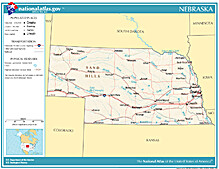
It is bordered by South Dakota to the north; Iowa to the east and Missouri to the southeast, both across the Missouri River; Kansas to the south; Colorado to the southwest; and Wyoming to the west. It is the only triply landlocked U.S. state. Three rivers cross the state from west to east. The Platte River, formed by the confluence of the North Platte and the South Platte, runs through the state's central portion, the Niobrara River flows through the northern part, and the Republican River runs across the southern part.
Nebraska is composed of two major land regions: the Dissected Till Plains and the Great Plains. The Dissected Till Plains region consists of gently rolling hills and contains the state's largest cities, Omaha and Lincoln. The Great Plains region, occupying most of western Nebraska, is characterized by treeless prairie. The Great Plains region consists of several smaller, diverse land regions, including the Sandhills, the Pine Ridge, the Rainwater Basin, the High Plains and the Wildcat Hills. Panorama Point, at 5,424 feet (1,653 m), is Nebraska's highest point; though despite its name and elevation, it is a relatively low rise near the Colorado and Wyoming borders. Nebraska has two major climatic zones. The eastern half of the state has a humid continental climate. The western half of the state has a primarily semi-arid climate. The state has wide variations between winter and summer temperatures, variations that decrease moving south within the state. Violent thunderstorms and tornadoes occur primarily during spring and summer and sometimes in autumn. Chinook wind tends to warm the state significantly in the winter and early spring.
Fun Facts
The Nebraska Legislature is unlike any other American legislature in that it is unicameral, and its members are elected without any official reference to political party affiliation
Arbor Day started in 1854 with a pioneer named J. Sterling Morton. An agriculture enthusiast, Morton immediately saw the need for more trees on the prairie when he moved from Detroit to Nebraska. By 1872, he had convinced the State Board of Agriculture to promote a day for everyone to plant trees “both forest and fruit.” The first Arbor Day was celebrated that year with more than a million trees planted in Nebraska alone. The National Arbor Day Foundation is still headquartered in Nebraska City, with some offices in Lincoln. The world’s largest hand-planted forest is Halsey National Forest near Thedford, Nebraska. The state nickname used to be the “Tree Planter’s State”, but was changed in 1945 to the “Cornhusker State”.
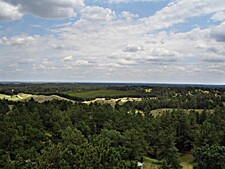
Nebraska is a landlocked state, but Nebraska does, in fact, have a Navy. It was commissioned in 1931 by Lt. Governor T.W. Metcalfe, who wanted to gift his friends with ridiculous and meaningless government appointments. The rank of Admiral is awarded to people who have “contributed in some way to the state, promote the Good Life in Nebraska, and warrant recognition as determined by the governor. Admirals include Queen Elizabeth II, Captain Kangaroo, Big Bird, Dr. J., John Glenn, and Bill Murray (obviously).
The state is split between two time zones, with the state's eastern half observing Central Time and the western half observing Mountain Time.
Kool-Aid was created in 1927 by Edwin Perkins in the city of Hastings, which celebrates the event the second weekend of every August with Kool-Aid Days, and Kool-Aid is the official soft drink of Nebraska. He changed his soft drink syrup, Fruit Smack, into a powder to make it easier to ship.
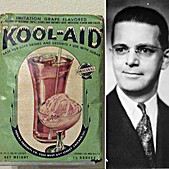
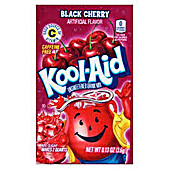
Nebraska has the U.S.’s largest aquifer (underground lake/water supply), the Ogalala aquifer. Additionally, Nebraska has more miles of river than any other state.
Buffalo Bill Cody held his first rodeo in North Platte, Nebraska July 4, 1882.
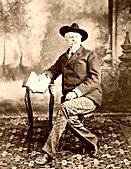
Elephant Hall, a museum in Lincoln, has the biggest collection of elephant skeletons in the world. The biggest mammoth fossils ever discovered were found in Lincoln County.
The Sand Hills are the biggest grass-covered sand dunes in the Western Hemisphere. They cover about one-fourth of the state. Only the Sahara and the Arabian deserts have bigger areas of sand.
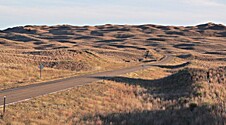
The first modern-day serial killer, Charles Starkweather was from Nebraska and is buried at Lincoln’s Wyuka Cemetery.
Nebraskans love their football. The Nebraska Cornhuskers’ football stadium holds more than 90,000 people. On game day, that makes it the third most populated place in the state, second only to Omaha (434,000) and Lincoln (268,000). Coming in a distant fourth is Bellevue, Nebraska, with a population of approximately 54,000. The Nebraska Cornhuskers have been to a record 27 consecutive bowl games and 27 consecutive winning seasons. The University of Nebraska Cornhusker football team has produced more Academic All-Americans than any other Division I school.

It wasn’t just Pearl Harbor that was hit during WWII. On April 18, 1945, a Japanese balloon bomb exploded in the sky over Dundee, a section of Omaha. Fortunately, it didn’t do much damage, and the attempt was kept hush-hush until after the war was over. In addition, Nebraska was bombed twice by Friendly Fire in WWII. The little town of Tarnov was bombed on August 19, 1943 - but no one was injured. The bombs were practice bombs probably dropped by B-17s from the Sioux City Army Air Field. The pilots had mistaken the town's lights for the lights that adorned a nearby bombing range. A similar story unfolded in nearby Dickens around the same time, with ten practice bombs landing in and around the little town.
Notable Residents
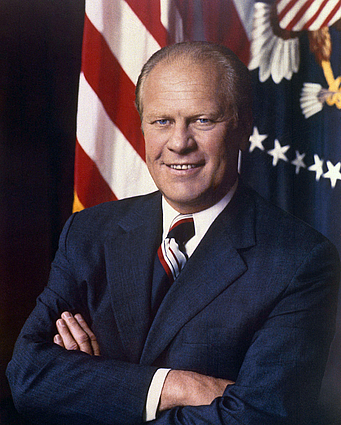
Gerald Rudolph Ford Jr., born Leslie Lynch King Jr. on July 14, 1913 was an American politician and attorney who served as the 38th president of the United States from 1974 to 1977. A member of the Republican Party, Ford previously served as the 40th vice president of the United States from 1973 to 1974. To date, Ford is the only person to have served as both vice president and president without being elected to either office by the Electoral College. Born in Omaha, Nebraska, and raised in Grand Rapids, Michigan, Ford attended the University of Michigan and Yale Law School. After the attack on Pearl Harbor, he enlisted in the U.S. Naval Reserve, serving from 1942 to 1946; he left as a lieutenant commander. Ford began his political career in 1949 as the U.S. representative from Michigan's 5th congressional district. He served in this capacity for 25 years, the final nine of them as the House Minority Leader. In December 1973, two months after the resignation of Spiro Agnew, Ford became the first person appointed to the vice presidency under the terms of the 25th Amendment by President Richard Nixon. After the subsequent resignation of President Nixon in August 1974, Ford immediately assumed the presidency. His 895-day-long presidency is the shortest in U.S. history for any president who did not die in office. Ford died in Rancho Mirage, California on December 26, 2006 at the age of 93.
Chief Red Cloud (1822-1909) was the chief of the Oglala Lakota (Sioux) tribe that followed the buffalo across the Great Plains. He was the only Native American to win a big war against the U.S. He won important treaties protecting his people’s land and later became an important diplomat from the Lakota to the U.S. government. Unfortunately, the U.S. later broke many of their treaties. This proud warrior died on a reservation.
Famous Nebraska natives include authors such as Alex Kava, Chigozie Obioma, Nicholas Sparks, Willa Cather, Sean Doolittle, John Rector, Brandon Sanderson and Rainbow Rowell.
The list of actors/actresses from Nebraska includes Janine Turner, Henry Fonda, Gabrielle Union, Jorge Garcia, Marg Helgenberger and Marlon Brando. Also from Nebraska are media personalities Johnny Carson and Paula Zahn and the co-founder of Twitter, Ev Williams.
Well-known athletes that hail from Nebraska include Gayle Sayers (football), Jim Hartung (Olympic gold medal for men's gymnastics), Mark Calcavecchia (golf), Paul Tierney (World All-Around Rodeo champion), and Steve Brooks (Kentucky Derby jockey).
In honor of NEBRASKA, read a Mystery/Suspense book (any sub-genre will do!) that satisfies one or more of the following:
• A Mystery/Suspense book with "Yellow," "Plain," "Cool (or Kool)," or "River" in the title OR has a cover that is more than 50% yellow OR has a tree or a cornfield (or other farm crop) on the cover;
• A Mystery/Suspense book that takes place during a long journey OR has a character that is/was an athlete or politician OR the story takes place in the Plains State of the United States;
• A Mystery/Suspense book where the author's initials (BOTH the first AND last) can be found in NEBRASKA.
Happy Reading ❤
The Americana Series Monthly Challenge – March 2021: Nebraska

History
Nebraska is a US state in the Midwestern region of the country. Nebraska is the 16th largest state with an area of just over 77,220 square miles (200,000 km2). Nebraska is 37th in population and 43rd in density with approximately 1.9 million people as of 2019. Its capital is Lincoln, and its largest city is Omaha, which is on the Missouri River. Nebraska's name is the result of anglicization of the archaic Otoe words Ñí Brásge, pronounced ɲĩbɾasꜜkɛ, meaning "flat water", after the Platte River which flows through the state.
Indigenous peoples lived in the region of present-day Nebraska for thousands of years before European colonization. The historic tribes in the state included the Omaha, Missouria, Ponca, Pawnee, Otoe, and various branches of the Lakota (Sioux), some of which migrated from eastern areas into this region. When European exploration, trade, and settlement began, both Spain and France sought to control the region. In the 1690s, Spain established trade connections with the Apaches, whose territory then included western Nebraska. By 1703, France had developed a regular trade with the native peoples along the Missouri River in Nebraska, and by 1719 had signed treaties with several of these peoples. After war broke out between the two countries, Spain dispatched an armed expedition to Nebraska under Lieutenant General Pedro de Villasur in 1720. The party was attacked and destroyed near present-day Columbus by a large force of Pawnees and Otoes, both allied with the French. The massacre ended Spanish exploration of the area for the remainder of the 18th century.
In 1762, during the Seven Years' War, France ceded the Louisiana territory to Spain. This left Britain and Spain competing for dominance along the Mississippi; by 1773, the British were trading with the native peoples of Nebraska. In response, Spain dispatched two trading expeditions up the Missouri in 1794 and 1795; the second, under James Mackay, established the first European settlement in Nebraska near the mouth of the Platte. Later that year, Mackay's party built a trading post, dubbed Fort Carlos IV (Fort Charles).
In 1819, the United States established Fort Atkinson as the first U.S. Army post west of the Missouri River, just east of present-day Fort Calhoun. The army abandoned the fort in 1827 as migration moved further west. European-American settlement was scarce until 1848 and the California Gold Rush. On May 30, 1854, the US Congress created the Kansas and the Nebraska territories, divided by the Parallel 40° North, under the Kansas–Nebraska Act. The Nebraska Territory included parts of the current states of Colorado, North Dakota, South Dakota, Wyoming, and Montana. The territorial capital of Nebraska was Omaha.
In the 1860s, after the U.S. government forced many of the Native American tribes to cede their lands and settle on reservations, it opened large tracts of land to agricultural development by Europeans and Americans. Under the Homestead Act, thousands of settlers migrated into Nebraska to claim free land granted by the federal government. Because so few trees grew on the prairies, many of the first farming settlers built their homes of sod, as had Native Americans such as the Omaha. The first wave of settlement gave the territory a sufficient population to apply for statehood. Nebraska became the 37th state on March 1, 1867, and the capital was moved from Omaha to the center at Lancaster, later renamed Lincoln after the recently assassinated President of the United States, Abraham Lincoln. The battle of Massacre Canyon, on August 5, 1873, was the last major battle between the Pawnee and the Sioux.
During the 1870s to the 1880s, Nebraska experienced a large growth in population. Several factors contributed to attracting new residents. The first was that the vast prairie land was perfect for cattle grazing. This helped settlers to learn the unfamiliar geography of the area. The second factor was the invention of several farming technologies. Agricultural inventions such as barbed wire, wind mills, and the steel plow, combined with good weather, enabled settlers to use Nebraska as prime farming land. By the 1880s, Nebraska's population had soared to more than 450,000 people.
In the late 19th century, many African Americans migrated from the South to Nebraska as part of the Great Migration, primarily to Omaha which offered working class jobs in meat packing, the railroads and other industries. Omaha has a long history of civil rights activism. Blacks encountered discrimination from other Americans in Omaha and especially from recent European immigrants, ethnic whites who were competing for the same jobs. In 1912, African Americans founded the Omaha chapter of the National Association for the Advancement of Colored People to work for improved conditions in the city and state.
Since the 1960s, Native American activism in the state has increased, both through open protest, activities to build alliances with state and local governments, and in the slower, more extensive work of building tribal institutions and infrastructure. Native Americans in federally recognized tribes have pressed for self-determination, sovereignty and recognition. They have created community schools to preserve their cultures, as well as tribal colleges and universities. Tribal politicians have also collaborated with state and county officials on regional issues.
Nebraska was admitted into the United States on March 1, 1867, two years after the end of the American Civil War.
Geography

It is bordered by South Dakota to the north; Iowa to the east and Missouri to the southeast, both across the Missouri River; Kansas to the south; Colorado to the southwest; and Wyoming to the west. It is the only triply landlocked U.S. state. Three rivers cross the state from west to east. The Platte River, formed by the confluence of the North Platte and the South Platte, runs through the state's central portion, the Niobrara River flows through the northern part, and the Republican River runs across the southern part.
Nebraska is composed of two major land regions: the Dissected Till Plains and the Great Plains. The Dissected Till Plains region consists of gently rolling hills and contains the state's largest cities, Omaha and Lincoln. The Great Plains region, occupying most of western Nebraska, is characterized by treeless prairie. The Great Plains region consists of several smaller, diverse land regions, including the Sandhills, the Pine Ridge, the Rainwater Basin, the High Plains and the Wildcat Hills. Panorama Point, at 5,424 feet (1,653 m), is Nebraska's highest point; though despite its name and elevation, it is a relatively low rise near the Colorado and Wyoming borders. Nebraska has two major climatic zones. The eastern half of the state has a humid continental climate. The western half of the state has a primarily semi-arid climate. The state has wide variations between winter and summer temperatures, variations that decrease moving south within the state. Violent thunderstorms and tornadoes occur primarily during spring and summer and sometimes in autumn. Chinook wind tends to warm the state significantly in the winter and early spring.
Fun Facts
The Nebraska Legislature is unlike any other American legislature in that it is unicameral, and its members are elected without any official reference to political party affiliation
Arbor Day started in 1854 with a pioneer named J. Sterling Morton. An agriculture enthusiast, Morton immediately saw the need for more trees on the prairie when he moved from Detroit to Nebraska. By 1872, he had convinced the State Board of Agriculture to promote a day for everyone to plant trees “both forest and fruit.” The first Arbor Day was celebrated that year with more than a million trees planted in Nebraska alone. The National Arbor Day Foundation is still headquartered in Nebraska City, with some offices in Lincoln. The world’s largest hand-planted forest is Halsey National Forest near Thedford, Nebraska. The state nickname used to be the “Tree Planter’s State”, but was changed in 1945 to the “Cornhusker State”.

Nebraska is a landlocked state, but Nebraska does, in fact, have a Navy. It was commissioned in 1931 by Lt. Governor T.W. Metcalfe, who wanted to gift his friends with ridiculous and meaningless government appointments. The rank of Admiral is awarded to people who have “contributed in some way to the state, promote the Good Life in Nebraska, and warrant recognition as determined by the governor. Admirals include Queen Elizabeth II, Captain Kangaroo, Big Bird, Dr. J., John Glenn, and Bill Murray (obviously).
The state is split between two time zones, with the state's eastern half observing Central Time and the western half observing Mountain Time.
Kool-Aid was created in 1927 by Edwin Perkins in the city of Hastings, which celebrates the event the second weekend of every August with Kool-Aid Days, and Kool-Aid is the official soft drink of Nebraska. He changed his soft drink syrup, Fruit Smack, into a powder to make it easier to ship.


Nebraska has the U.S.’s largest aquifer (underground lake/water supply), the Ogalala aquifer. Additionally, Nebraska has more miles of river than any other state.
Buffalo Bill Cody held his first rodeo in North Platte, Nebraska July 4, 1882.

Elephant Hall, a museum in Lincoln, has the biggest collection of elephant skeletons in the world. The biggest mammoth fossils ever discovered were found in Lincoln County.
The Sand Hills are the biggest grass-covered sand dunes in the Western Hemisphere. They cover about one-fourth of the state. Only the Sahara and the Arabian deserts have bigger areas of sand.

The first modern-day serial killer, Charles Starkweather was from Nebraska and is buried at Lincoln’s Wyuka Cemetery.
Nebraskans love their football. The Nebraska Cornhuskers’ football stadium holds more than 90,000 people. On game day, that makes it the third most populated place in the state, second only to Omaha (434,000) and Lincoln (268,000). Coming in a distant fourth is Bellevue, Nebraska, with a population of approximately 54,000. The Nebraska Cornhuskers have been to a record 27 consecutive bowl games and 27 consecutive winning seasons. The University of Nebraska Cornhusker football team has produced more Academic All-Americans than any other Division I school.

It wasn’t just Pearl Harbor that was hit during WWII. On April 18, 1945, a Japanese balloon bomb exploded in the sky over Dundee, a section of Omaha. Fortunately, it didn’t do much damage, and the attempt was kept hush-hush until after the war was over. In addition, Nebraska was bombed twice by Friendly Fire in WWII. The little town of Tarnov was bombed on August 19, 1943 - but no one was injured. The bombs were practice bombs probably dropped by B-17s from the Sioux City Army Air Field. The pilots had mistaken the town's lights for the lights that adorned a nearby bombing range. A similar story unfolded in nearby Dickens around the same time, with ten practice bombs landing in and around the little town.
Notable Residents

Gerald Rudolph Ford Jr., born Leslie Lynch King Jr. on July 14, 1913 was an American politician and attorney who served as the 38th president of the United States from 1974 to 1977. A member of the Republican Party, Ford previously served as the 40th vice president of the United States from 1973 to 1974. To date, Ford is the only person to have served as both vice president and president without being elected to either office by the Electoral College. Born in Omaha, Nebraska, and raised in Grand Rapids, Michigan, Ford attended the University of Michigan and Yale Law School. After the attack on Pearl Harbor, he enlisted in the U.S. Naval Reserve, serving from 1942 to 1946; he left as a lieutenant commander. Ford began his political career in 1949 as the U.S. representative from Michigan's 5th congressional district. He served in this capacity for 25 years, the final nine of them as the House Minority Leader. In December 1973, two months after the resignation of Spiro Agnew, Ford became the first person appointed to the vice presidency under the terms of the 25th Amendment by President Richard Nixon. After the subsequent resignation of President Nixon in August 1974, Ford immediately assumed the presidency. His 895-day-long presidency is the shortest in U.S. history for any president who did not die in office. Ford died in Rancho Mirage, California on December 26, 2006 at the age of 93.
Chief Red Cloud (1822-1909) was the chief of the Oglala Lakota (Sioux) tribe that followed the buffalo across the Great Plains. He was the only Native American to win a big war against the U.S. He won important treaties protecting his people’s land and later became an important diplomat from the Lakota to the U.S. government. Unfortunately, the U.S. later broke many of their treaties. This proud warrior died on a reservation.
Famous Nebraska natives include authors such as Alex Kava, Chigozie Obioma, Nicholas Sparks, Willa Cather, Sean Doolittle, John Rector, Brandon Sanderson and Rainbow Rowell.
The list of actors/actresses from Nebraska includes Janine Turner, Henry Fonda, Gabrielle Union, Jorge Garcia, Marg Helgenberger and Marlon Brando. Also from Nebraska are media personalities Johnny Carson and Paula Zahn and the co-founder of Twitter, Ev Williams.
Well-known athletes that hail from Nebraska include Gayle Sayers (football), Jim Hartung (Olympic gold medal for men's gymnastics), Mark Calcavecchia (golf), Paul Tierney (World All-Around Rodeo champion), and Steve Brooks (Kentucky Derby jockey).
In honor of NEBRASKA, read a Mystery/Suspense book (any sub-genre will do!) that satisfies one or more of the following:
• A Mystery/Suspense book with "Yellow," "Plain," "Cool (or Kool)," or "River" in the title OR has a cover that is more than 50% yellow OR has a tree or a cornfield (or other farm crop) on the cover;
• A Mystery/Suspense book that takes place during a long journey OR has a character that is/was an athlete or politician OR the story takes place in the Plains State of the United States;
• A Mystery/Suspense book where the author's initials (BOTH the first AND last) can be found in NEBRASKA.
Happy Reading ❤
2bhabeck
Brenda's March 2021 Americana Challenge - Nebraska
3 of 3 Complete
In honor of NEBRASKA, read a Mystery/Suspense book (any sub-genre will do!) that satisfies one or more of the following:
• A Mystery/Suspense book with "Yellow," "Plain," "Cool (or Kool)," or "River" in the title OR has a cover that is more than 50% yellow OR has a tree or a cornfield (or other farm crop) on the cover;
In Plain Sight by Linda Castillo; 3/14/21; 2 stars
• A Mystery/Suspense book that takes place during a long journey OR has a character that is/was an athlete or politician OR the story takes place in the Plains State of the United States;
The Last Passenger by Charles Finch; Murder victim was a US congressman; 3/4/21; 4 stars
• A Mystery/Suspense book where the author's initials (BOTH the first AND last) can be found in NEBRASKA.
The Last Widow by Karin Slaughter; 3/13/21; 4 stars
3 of 3 Complete
In honor of NEBRASKA, read a Mystery/Suspense book (any sub-genre will do!) that satisfies one or more of the following:
• A Mystery/Suspense book with "Yellow," "Plain," "Cool (or Kool)," or "River" in the title OR has a cover that is more than 50% yellow OR has a tree or a cornfield (or other farm crop) on the cover;
In Plain Sight by Linda Castillo; 3/14/21; 2 stars
• A Mystery/Suspense book that takes place during a long journey OR has a character that is/was an athlete or politician OR the story takes place in the Plains State of the United States;
The Last Passenger by Charles Finch; Murder victim was a US congressman; 3/4/21; 4 stars
• A Mystery/Suspense book where the author's initials (BOTH the first AND last) can be found in NEBRASKA.
The Last Widow by Karin Slaughter; 3/13/21; 4 stars
3Carol420
Carol Forgot to Feed Her Elephant
23of 3 Complete -DONE - 3/10
📌 - ★
📌1. A Mystery/Suspense book with "Yellow," "Plain," "Cool (or Kool)," or "River" in the title OR has a cover that is more than 50% yellow OR has a tree or a cornfield (or other farm crop) on the cover.
The Last Laugh – Michelle Dorey - 5★
📌2. A Mystery/Suspense book that takes place during a long journey OR has a character that is/was an athlete or politician OR the story takes place in the Plains State of the United States (Wyoming)
Best Laid Plans - Roan Parrish - 4.5★
📌3. A Mystery/Suspense book where the author's initials (BOTH the first AND last) can be found in NEBRASKA.
Plan B - Emily Barr - ★ (E & B)
4Sergeirocks
Saving my place, ☺️
A Mansion and Its Murder - Robert Barnard 4.5★s (Author's initials in NEBRASKA)
The River Murders - James Patterson & James O. Born 3.75★s ("River" in the title)
Open Season - C. J. Box 4★s (Story takes place in the Plains State)
>6 gaylebutz: Thank you, Gayle, for pointing me in the direction of C. J. Box 🙂
A Mansion and Its Murder - Robert Barnard 4.5★s (Author's initials in NEBRASKA)
The River Murders - James Patterson & James O. Born 3.75★s ("River" in the title)
Open Season - C. J. Box 4★s (Story takes place in the Plains State)
>6 gaylebutz: Thank you, Gayle, for pointing me in the direction of C. J. Box 🙂
5Olivermagnus
When I was a little tyke I read this book about the Huckabuck family: Jonas Jonas, Mama Mama and Pony Pony. I thought Pony Pony was such a great name. Every time I think of Nebraska, I remember this book

The Huckabuck Family And How They Raised Popcorn in Nebraska
0 of 3 Complete
In honor of NEBRASKA, read a Mystery/Suspense book (any sub-genre will do!) that satisfies one or more of the following:
• A Mystery/Suspense book with "Yellow," "Plain," "Cool (or Kool)," or "River" in the title OR has a cover that is more than 50% yellow OR has a tree or a cornfield (or other farm crop) on the cover;
🐄 A Mystery/Suspense book that takes place during a long journey OR has a character that is/was an athlete or politician OR the story takes place in the Plains State of the United States
Blood Trail - C. J. Box - 4.5 Stars - 3/11/21 - set in Wyoming
🐄 A Mystery/Suspense book where the author's initials (BOTH the first AND last) can be found in NEBRASKA.
Deadly Sanctuary - Sylvia Nobel - 3/21/21 - SN

The Huckabuck Family And How They Raised Popcorn in Nebraska
0 of 3 Complete
In honor of NEBRASKA, read a Mystery/Suspense book (any sub-genre will do!) that satisfies one or more of the following:
• A Mystery/Suspense book with "Yellow," "Plain," "Cool (or Kool)," or "River" in the title OR has a cover that is more than 50% yellow OR has a tree or a cornfield (or other farm crop) on the cover;
🐄 A Mystery/Suspense book that takes place during a long journey OR has a character that is/was an athlete or politician OR the story takes place in the Plains State of the United States
Blood Trail - C. J. Box - 4.5 Stars - 3/11/21 - set in Wyoming
🐄 A Mystery/Suspense book where the author's initials (BOTH the first AND last) can be found in NEBRASKA.
Deadly Sanctuary - Sylvia Nobel - 3/21/21 - SN
6gaylebutz
I'm going to read In Plain Sight by C. J. Box.
It has "Plain" in the title and the story takes place in the Plains State of the United States - Wyoming.
It has "Plain" in the title and the story takes place in the Plains State of the United States - Wyoming.
7jguidry
Jaret looks for needlework stores in Nebraska
(0/3 completed)
• A Mystery/Suspense book with "Yellow," "Plain," "Cool (or Kool)," or "River" in the title OR has a cover that is more than 50% yellow OR has a tree or a cornfield (or other farm crop) on the cover;
• A Mystery/Suspense book that takes place during a long journey OR has a character that is/was an athlete or politician OR the story takes place in the Plains State of the United States;
• A Mystery/Suspense book where the author's initials (BOTH the first AND last) can be found in NEBRASKA.
(0/3 completed)
• A Mystery/Suspense book with "Yellow," "Plain," "Cool (or Kool)," or "River" in the title OR has a cover that is more than 50% yellow OR has a tree or a cornfield (or other farm crop) on the cover;
• A Mystery/Suspense book that takes place during a long journey OR has a character that is/was an athlete or politician OR the story takes place in the Plains State of the United States;
• A Mystery/Suspense book where the author's initials (BOTH the first AND last) can be found in NEBRASKA.
8gaylebutz
Done - In Plain Sight by C. J. Box - 4.5 ★
It has "Plain" in the title and the story takes place in a Plains State of the United States - Wyoming.
It has "Plain" in the title and the story takes place in a Plains State of the United States - Wyoming.
10bhabeck
>2 bhabeck: done!
11bhabeck
>4 Sergeirocks: >6 gaylebutz: Well done!
15nrmay
>5 Olivermagnus:
I have loved the Huckabuck Family all my life! I have a copy of that.
I read Exit by Belinda Bauer. initials in Nebraska.
I have loved the Huckabuck Family all my life! I have a copy of that.
I read Exit by Belinda Bauer. initials in Nebraska.
Únete para publicar

